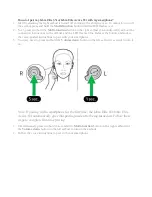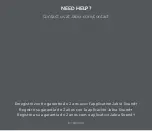
Wireless Regulatory Information
1
Wireless Regulatory Information
FCC Statement
This device complies with Part 15 of the FCC Rules. Operation is subject
to the following two conditions: (1) This device may not cause harmful
interference, and (2) this device must accept any interference received,
including interference that may cause undesired operation.
This product has been tested and complies with the specifications for
a Class B digital device, pursuant to Part 15 of the FCC Rules. These
limits are designed to provide reasonable protection against harmful
interference in a residential installation. This equipment generates,
uses, and can radiate radio frequency energy and, if not installed and
used according to the instructions, may cause harmful interference to
radio communications. However, there is no guarantee that interference
will not occur in a particular installation. If this equipment does cause
harmful interference to radio or television reception, which is found
by turning the equipment off and on, the user is encouraged to try
to correct the interference by one or more of the following measures:
•
Reorient or relocate the receiving antenna
•
Increase the separation between the equipment and devices
•
Connect the equipment to an outlet other than the receiver’s
•
Consult a dealer or an experienced radio/TV technician for assistance
FCC Caution: Any changes or modifications not expressly approved by
the party responsible for compliance could void the user’s authority to
operate this equipment.
2.4GHz operation of this product in the USA is firmware-limited to
channels 1 through 11.
The device for the band 5150-5250 MHz is only for indoor usage to
reduce the potential for harmful interference to co-channel mobile
satellite systems.
FCC Radiation Exposure Statement
This equipment complies with FCC radiation exposure limits set forth for
an uncontrolled environment. This equipment should be installed and
operated with minimum distance 35 cm between the radiator and your body.
This device and it’s antennas(s) must not be co-located or operating
in conjunction with any other antenna or transmitter except in
accordance with FCC multi-transmitter product procedures.
Innovation, Science and Economic Development
Canada Statement
CAN ICES-3 (B)/NMB-3 (B)
This device complies with ISED’s license-exempt RSS standards.
Operation is subject to the following two conditions: (1) This device may
not cause interference, and (2) this device must accept any interference,
including interference that may cause undesired operation of the device.
For product available in the USA/Canada market, only channel 1~11 can
be operated. Selection of other channels is not possible.
The device could automatically discontinue transmission in case of
absence of information to transmit, or operational failure. Note that this is
not intended to prohibit transmission of control or signaling information
or the use of repetitive codes where required by the technology.
Innovation, Science and Economic Development
Canada Radiation Exposure Statement
This equipment complies with ISED radiation exposure limits set forth
for an uncontrolled environment. This equipment should be installed and
operated with minimum distance 35 cm between the radiator & your body.
This device and it’s antennas(s) must not be co-located or operating in
conjunction with any other antenna or transmitter except in accordance
with ISED multi-transmitter product procedures.
Restrictions in the 5 GHz Band
The device for the band 5150-5250 MHz is only for indoor usage
to reduce potential for harmful interference to co-channel mobile
satellite systems.
This device has been designed to operate with an antenna having a
maximum gain of 2.93 dBi and 3.18 dBi at 2.4 GHz and 5 GHz respectively.
Antenna having a higher gain is strictly prohibited per regulations of
ISED. The required antenna impedance is 50 ohms.
The maximum antenna gain (Please see the table below) permitted (for
devices in the bands 5250-5350 MHz and 5470-5725 MHz) to comply
with the EIRP limit and the maximum antenna gain permitted for
devices in the band 5725-5850 MHz shall be such that the equipment
still complies with the EIRP limits specified for point-to-point and non-
point-to-point operation as appropriate because high power radars
are allocated as primary users (meaning they have priority) in 5250-
5350 MHz and 5650-5850 MHz, these radars could cause interference
and/or damage to license exempt LAN devices. The worst-case tilt
angle(s) necessary to remain compliant with the e.i.r.p. elevation mask
requirement set forth in Section 6.2.2(3) shall be clearly indicated.
No.
Antenna
Type
For 2.4 GHz
Gain (dBi)
For 5 GHz
Gain (dBi)
Antenna
Connector
1
Dipole
2.93
3.18
I-PEX (MHF)
2
Dipole
2.82
2.95
I-PEX (MHF)
Additional requirements for the band 5600-
5650 MHz
Until further notice, devices subject to this Section shall not be capable
of transmitting in the band 5600-5650 MHz, so that Environment
Canada weather radars operating in this band are protected.
Avis d’Innovation, Sciences et Développement
économique Canada
CAN ICES-3 (B)/NMB-3 (B).
Le présent appareil est conforme aux CNR d’ ISED applicables aux
appareils radio exempts de licence. L’exploitation est autorisée
seulement aux conditions suivantes : (1) l’appareil ne doit pas produire
de brouillage, et (2) il doit accepter tout brouillage radioélectrique
reçu, même si ce brouillage est susceptible de compromettre le
fonctionnement du dispositif.




































